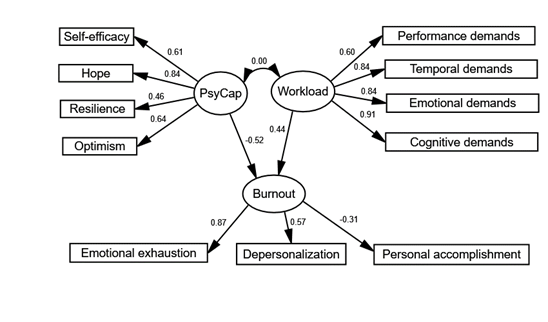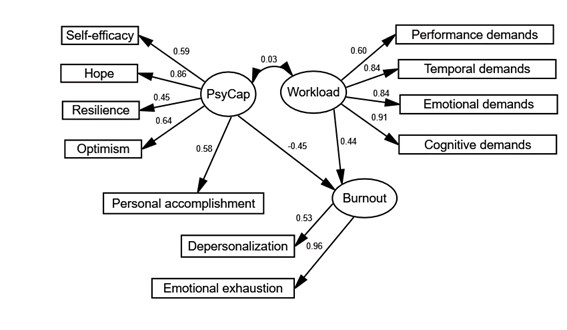Research on burnout has traditionally focused on job demands, with less attention paid to protective factors. From the emerging and innovative area of psychology of sustainability and sustainable development, this sentudry aimed to analyze the relationship that job demands (workload), and personal resources (psychological capital) have with burnout. The sample includes 517 workers from various professional sectors. Results of the structural equation analysis show that (1) psychological capital and workload are related to burnout, and (2) personal accomplishment is more a personal resource than burnout dimension. The results confirm the role of psychological capital as a protective factor for burnout. Finally, the importance of examining the relationship between the components of psychological capital, personal accomplishment, and positive emotions is pointed out due to the importance of organizations promoting the development of psychological strengths and resources to promote well-being and sustainable working conditions.
- psychological capital
- burnout
- workload
- personal accomplishment structural equation modell
- well-being
- psychology of sustainability and sustainable devel
1. Introduction
Burnout is a public health problem that involves great economic and social cost. Therefore, the World Health Organization (WHO) has recently decided to include burnout syndrome as a work-related problem in the next Review of the International Classification of Diseases (ICD-11). This will take effect on 1 January 2022. Burnout is an individual reaction to interpersonal and emotional stress [1] and has been defined as a syndrome with three dimensions: emotional exhaustion, depersonalization, and reduced personal accomplishment [2]. Emotional exhaustion is characterized by a lack of energy and feelings of being emotionally drained. Depersonalization refers to negative reactions towards people encountered at work. Reduced personal accomplishment is seen as negative self-assessment and a feeling of failed performance at work [3]. Several studies have indicated that burnout affects physical and mental health [4][5][6] and has a negative impact on employee performance and job satisfaction [7][8].
Recent studies have shown that individual factors are closely related to burnout and that they should be examined in future studies [9][10]. Several authors consider that the dimension personal accomplishment has a separate role from both emotional exhaustion and depersonalization, and therefore represents a perceived professional efficacy [11][12]. That is, personal accomplishment would reflect the workers’ personal characteristics and not their reactions to stressful situations [13][14] so it may be considered not a burnout dimension but an individual resource that develops largely independently of emotional exhaustion and depersonalization [15]. However, few studies have considered the personal accomplishment for coping with burnout and improving the conceptual framework on work stress and behavioral/health outcomes [16].
One of the most important individual resources that has received a lot of attention and could be a deterrent against job burnout is psychological capital (PsyCap) [17][18]. The term PsyCap refers to: “an individual’s positive psychological state of development and is characterized by: (a) having confidence (self-efficacy) to take on and put in the necessary effort to succeed at challenging tasks; (b) making a positive attribution (optimism) about succeeding now and in the future; (c) persevering towards goals and, when necessary, redirecting paths to goals (hope) in order to succeed; and (d) when beset by problems and adversity, sustaining and bouncing back and even beyond (resiliency) to attain success” [19].
PsyCap is significantly and positively correlated with personal accomplishment and negatively correlated with emotional exhaustion [20][21]. In addition, the four components of PsyCap have a profound effect on reducing job burnout and increasing physical and mental well-being.
Previous research has shown that PsyCap could be a positive resource to cope with job burnout [22][23]. Despite these results, the study of the relationship between job demands (e.g., workload) and individual variables (e.g., PsyCap) has received less attention[24], so more research about the role of personal resources and job demands on the development of burnout is needed to design efficient strategies of prevention.
Based on the consulted literature, the main purpose of this research is to test two models of burnout. In Model 1, we test the traditional tridimensional concept of burnout and the structure of relations with workload and PsyCap. In Model 2, we test a model of burnout considering it as formed by two dimensions (emotional exhaustion and depersonalization) and personally accomplished as a personal resource, so more related to PsyCap.
2. Data and Results
Model 1: The results showed direct effects of both PsyCap and the workload on burnout (Figure 1). Both effects were statistically significant (p < 0.001). The results show that the greater the PsyCap, the lesser burnout, while as the workload increases, burnout rises.
Figure 1. Effects of Psychological Capital and workload on burnout. Model 1.
Regarding measurement of burnout, the model shows that although all the regression coefficients were significant for the three dimensions—p < 0.001 that is, emotional exhaustion, depersonalization, and personal accomplishment—the last dimension, personal accomplishment, had less weight than the other two.
Model 2: Results showed direct effects of both psychological capital and workload on burnout (Figure 2). Both effects were statistically significant (p < 0.001) and were along the same lines as the results in Model 1: the greater the psychological capital, the lower burnout, while as the workload increases, there is an increase in burnout levels.
Figure 2. Effects of Personal accomplishment on burnout. Model 2.
3. Conclusions
The psychology of sustainability and sustainable development underlines a prevention approach and promotes well-being in individuals and organizations to sustainable development and global growth.
There is a high direct and positive relationship between psychological capital and the dimension of personal accomplishment. The psychological capital seems to be a protective factor to burnout which contribute to employee health and well-being. By the other hand, the personal achievement does not fulfill the key role of burnout, but is a crucial personal resource to cope with it. These results could serve to address a new conceptualization of burnout and move from a conceptualization of three components to a burnout model in the framework of work stress and preventive perspective.
Considering that burnout is a public health problem involving great economic and social cost, the main contribution of this study is to show the role of individual resources as protectors from burnout and that the personal accomplishment is more a dimension of personal resources which opens up new perspectives for intervention on these factors, since we could act not only on the situational variables that predict burnout, but also on the personal variables, making more effective interventions to prevent burnout, promote well-being, and sustainable working conditions and organizations.
References
- Demerouti, E.; Bakker, A.B.; Nachreiner, F.; Schaufeli, W.B. The job demands-resources model of burnout. J. Appl. Psychol. 2001, 86, 499–512, doi:10.1037/0021-9010.86.3.499.
- Maslach, C.; Schaufeli, W.B.; Leiter, M.P. Job Burnout. Annu. Rev. Psychol. 2001, 52, 397–422, doi:10.1146/annurev.psych.52.1.397.
- Maslach, C. Burnout: A multidimensional perspective. In Professional Burnout, 1st ed.; Routledge: Abingdon, UK, 1993.
- Lindwall, M.; Gerber, M.; Jonsdottir, I.H.; Börjesson, M.; Ahlborg, G. The relationships of change in physical activity with change in depression, anxiety, and burnout: A longitudinal study of Swedish healthcare workers. Health Psychol. 2014, 33, 1309–1318, doi:10.1037/a0034402.
- Ding, Y.; Yang, Y.; Yang, X.; Zhang, T.; Qiu, X.; He, X.; Wang, W.; Wang, L.; Sui, H. The Mediating Role of Coping Style in the Relationship between Psychological Capital and Burnout among Chinese Nurses. PLoS ONE 2015, 10, e0122128, doi:10.1371/journal.pone.0122128.
- Estiri, M.; Nargesian, A.; Dastpish, F.; Sharifi, M. The impact of psychological capital on mental health among Iranian nurses: Considering the mediating role of job burnout. SpringerPlus 2016, 5, 1–5, doi:10.1186/s40064-016-3099-z.
- Lin, Q.-H.; Jiang, C.-Q.; Lam, T.H. The Relationship between Occupational Stress, Burnout, and Turnover Intention among Managerial Staff from a Sino-Japanese Joint Venture in Guangzhou, China. J. Occup. Health 2013, 55, 458–467, doi:10.1539/joh.12-0287-oa.
- Shaukat, R.; Yousaf, A.; Sanders, K. Examining the linkages between relationship conflict, performance and turnover intentions. Int. J. Confl. Manag. 2017, 28, 4–23, doi:10.1108/ijcma-08-2015-0051.
- Alarcon, G.M.; Eschleman, K.J.; Bowling, N.A. Relationships between personality variables and burnout: A meta-analysis. Work Stress 2009, 23, 244–263, doi:10.1080/02678370903282600.
- Swider, B.W.; Zimmerman, R.D. Born to burnout: A meta-analytic path model of personality, job burnout, and work outcomes. J. Vocat. Behav. 2010, 76, 487–506, doi:10.1016/j.jvb.2010.01.003.
- Lee, R.T.; Ashforth, B.E. A meta-analytic examination of the correlates of the three dimensions of job burnout. J. Appl. Psychol. 1996, 81, 123–133.
- Koeske, G.F.; Koeske, R.D. A Preliminary Test of a Stress-Strain-Outcome Model for Reconceptualizing the Burnout Phenomenon. J. Soc. Serv. Res. 1993, 17, 107–135, doi:10.1300/j079v17n03_06.
- Schaufeli,W.B.; Enzmann, D. The Burnout Companion to Study & Practice: A Critical Essay; Taylor & Francis: New York, NY, USA, 1998.
- Vîrgǎ, D.M.; Baciu, E.-L.; Lazăr, T.-A.; Lupșa, D. Psychological Capital Protects Social Workers from Burnout and Secondary Traumatic Stress. Sustainability 2020, 12, 2246, doi:10.3390/su12062246.
- Schaufeli, W.; Bakker, A.B. Job demands, job resources, and their relationship with burnout and engagement: A multi-sample study. J. Organ. Behav. 2004, 25, 293–315, doi:10.1002/job.248.
- Zawadzka, A.; Kościelniak, M.; Zalewska, A.M. The Big Five and Burnout among Teachers: The Moderating and Mediating Role of Self-Efficacy. Pol. Psychol. Bull. 2018, 49, 2, doi:10.1111/joop.12225.
- Li, X.; Kan, D.; Liu, L.; Shi, M.; Wang, Y.; Yang, X.; Wang, J.; Wang, L.; Wu, H. The Mediating Role of Psychological Capital on the Association between Occupational Stress and Job Burnout among Bank Employees in China. Int. J. Environ. Res. Public Health 2015, 12, 2984–3001, doi:10.3390/ijerph120302984.
- Rehman, S.U.; Cao, Q.; Latif, Y.; Iqbal, P. Impact of psychological capital on occupational burnout and performance of faculty members. Int. J. Educ. Manag. 2017, 31, 455–469, doi:10.1108/ijem-01-2016-0011.
- Luthans, F.; Avolio, B.J.; Youssef, C.M. Psychological Capital: Developing the Human Competitive Edge; Oxford University Press: New York, NY, USA, 2006.
- Laschinger, H.K.S.; Grau, A.L. The influence of personal dispositional factors and organizational resources on workplace violence, burnout, and health outcomes in new graduate nurses: A cross-sectional study. Int. J. Nurs. Stud. 2012, 49, 282–291, doi:10.1016/j.ijnurstu.2011.09.004.
- Ahmed, H.; Metwaly, S.M.; Ahmed, A.E. The impact of psychiatric nurses’ psychological capital on their burnout and coping style. Egypt. Nurs. J. 2018, 15, 302–313, doi:10.4103/enj.enj_21_18.
- Laschinger, H.K.S.; Fida, R. New nurses burnout and workplace wellbeing: The influence of authentic leadership and psychological capital. Burn. Res. 2014, 1, 19–28, doi:10.1016/j.burn.2014.03.002.
- Bakker, A.B.; Demerouti, E. Job demands-resources theory: Taking stock and looking forward. J. Occup. Health Psychol. 2017, 22, 273–285, doi:10.1037/ocp0000056.
- Bakker, A.B.; Demerouti, E.; Sanz-Vergel, A.I. Burnout and Work Engagement: The JD–R Approach. Annu. Rev. Organ. Psych. 2014, 1, 389–411, doi:10.1146/annurev-orgpsych-031413-091235.
- Maslach, C.; Schaufeli, W.B.; Leiter, M.P. Job Burnout. Annu. Rev. Psychol. 2001, 52, 397–422, doi:10.1146/annurev.psych.52.1.397.




